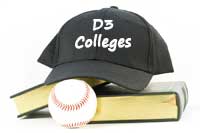 As the cost of attending state flagship universities passes $30,000, many families are considering the financial benefits of starting at a community college and then transfer to a 4-year university. Combining living at home with paying only a third to half of the tuition of a 4 year public institution represents significant savings. However, those savings will exist only if students actual path in real life follows the plan–and that is far from being certain.
As the cost of attending state flagship universities passes $30,000, many families are considering the financial benefits of starting at a community college and then transfer to a 4-year university. Combining living at home with paying only a third to half of the tuition of a 4 year public institution represents significant savings. However, those savings will exist only if students actual path in real life follows the plan–and that is far from being certain.
50-50 College Highlights
50-50 Highlights: NCAA D3 Colleges
 When high school athletes and their families start looking at colleges, it often comes as a surprise to many that the largest NCAA division, D3, doesn’t offer athletic scholarships. Students may receive academic scholarships and financial aid but no scholarship for participating in collegiate athletics.
When high school athletes and their families start looking at colleges, it often comes as a surprise to many that the largest NCAA division, D3, doesn’t offer athletic scholarships. Students may receive academic scholarships and financial aid but no scholarship for participating in collegiate athletics.
50-50 Highlights: Test Optional Colleges
 Students everywhere who struggle with standardized tests appreciate the increasing number of test optional colleges. However, it’s important to understand that there isn’t any one definition of “test optional.” Furthermore, just because a college states that it’s test optional for admissions doesn’t mean that tests aren’t required for scholarships or course placement. So be sure to check out the colleges for their specific requirements.
Students everywhere who struggle with standardized tests appreciate the increasing number of test optional colleges. However, it’s important to understand that there isn’t any one definition of “test optional.” Furthermore, just because a college states that it’s test optional for admissions doesn’t mean that tests aren’t required for scholarships or course placement. So be sure to check out the colleges for their specific requirements.
50-50 Highlights: Don’t Overlook These 105 Liberal Arts Colleges
 US News Best College Rankings consists of two national lists: National Universities and National Liberal Arts Colleges. Most people recognize the schools at the top of the National Universities list. Those at the top of the National Liberal Arts lists? Not so much. The reason is because by definition, Liberal Arts Colleges (LAC) are smaller, have a limited number of majors, and few, if any graduate students. And this makes them some of the most effective college teaching experiences around.
US News Best College Rankings consists of two national lists: National Universities and National Liberal Arts Colleges. Most people recognize the schools at the top of the National Universities list. Those at the top of the National Liberal Arts lists? Not so much. The reason is because by definition, Liberal Arts Colleges (LAC) are smaller, have a limited number of majors, and few, if any graduate students. And this makes them some of the most effective college teaching experiences around.
50-50 Highlights: Most Expensive Colleges
 The point of the 50-50 schools list is to identify colleges and universities that most students can get into while meeting a minimum standard for college graduation. However, just because a school is academically accessible doesn’t mean that students can afford to attend. Some of the most expensive colleges make the list. Like colleges and universities in general, colleges on the 50-50 list vary dramatically in their financial aid generosity.
The point of the 50-50 schools list is to identify colleges and universities that most students can get into while meeting a minimum standard for college graduation. However, just because a school is academically accessible doesn’t mean that students can afford to attend. Some of the most expensive colleges make the list. Like colleges and universities in general, colleges on the 50-50 list vary dramatically in their financial aid generosity.
50-50 Highlights: Colleges for Asian Students
 Asians and Pacific Islanders represent 5.7% of the general population but make-up 6.6% of all undergraduates. There are two to four times more Asians at the most competitive schools than in the general population. Asian students make up 21% of undergraduates at Stanford and 19% at Harvard. Because of this “over-representation” and general “model minority” myth, Asian students are often perceived as doing well no matter where they attend school.
Asians and Pacific Islanders represent 5.7% of the general population but make-up 6.6% of all undergraduates. There are two to four times more Asians at the most competitive schools than in the general population. Asian students make up 21% of undergraduates at Stanford and 19% at Harvard. Because of this “over-representation” and general “model minority” myth, Asian students are often perceived as doing well no matter where they attend school.
50-50 Highlights: Average College Endowment per Student
 Why look at a college’s endowment when trying to decide where to go to school? This falls into the category of all other things being equal, why not attend an institution that is in a better financial situation? Or more importantly, why risk going to a university that is facing financial difficulties?
Why look at a college’s endowment when trying to decide where to go to school? This falls into the category of all other things being equal, why not attend an institution that is in a better financial situation? Or more importantly, why risk going to a university that is facing financial difficulties?
50-50 Highlights: 89 Best Bets for Affordable Public Universities
 Let me start by saying you never know how much a college is actually going to cost until you get the college’s financial aid award. That’s when you really know if a college is affordable. But there are indicators that some colleges are more likely to be affordable than others. Knowing these indicators mean that you can make sure you apply to colleges more likely to meet your financial needs. That doesn’t guarantee they will because we are talking averages here. But it does improve your chances.
Let me start by saying you never know how much a college is actually going to cost until you get the college’s financial aid award. That’s when you really know if a college is affordable. But there are indicators that some colleges are more likely to be affordable than others. Knowing these indicators mean that you can make sure you apply to colleges more likely to meet your financial needs. That doesn’t guarantee they will because we are talking averages here. But it does improve your chances.
50-50 Highlights: Public Universities with Highest Percentage of PLUS Loans by State
 With all the talk about student debt, it’s easy to miss the PLUS loan numbers. PLUS loans are federal loans taken out by parents on the student’s behalf. The really scary thing about PLUS loans is that parents can borrow up to the full amount of tuition. Furthermore, eligibility for PLUS loans isn’t based on ability to repay the loan but rather your credit history. Just think about it, even with a great credit history, a bank won’t loan you money for $250,000 house without some evidence that you can make the payments. The government will.
With all the talk about student debt, it’s easy to miss the PLUS loan numbers. PLUS loans are federal loans taken out by parents on the student’s behalf. The really scary thing about PLUS loans is that parents can borrow up to the full amount of tuition. Furthermore, eligibility for PLUS loans isn’t based on ability to repay the loan but rather your credit history. Just think about it, even with a great credit history, a bank won’t loan you money for $250,000 house without some evidence that you can make the payments. The government will.









